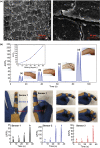Graphene Nanostructure-Based Tactile Sensors for Electronic Skin Applications
- PMID: 34138011
- PMCID: PMC7770800
- DOI: 10.1007/s40820-019-0302-0
Graphene Nanostructure-Based Tactile Sensors for Electronic Skin Applications
Abstract
Skin is the largest organ of the human body and can perceive and respond to complex environmental stimulations. Recently, the development of electronic skin (E-skin) for the mimicry of the human sensory system has drawn great attention due to its potential applications in wearable human health monitoring and care systems, advanced robotics, artificial intelligence, and human-machine interfaces. Tactile sense is one of the most important senses of human skin that has attracted special attention. The ability to obtain unique functions using diverse assembly processible methods has rapidly advanced the use of graphene, the most celebrated two-dimensional material, in electronic tactile sensing devices. With a special emphasis on the works achieved since 2016, this review begins with the assembly and modification of graphene materials and then critically and comprehensively summarizes the most advanced material assembly methods, device construction technologies and signal characterization approaches in pressure and strain detection based on graphene and its derivative materials. This review emphasizes on: (1) the underlying working principles of these types of sensors and the unique roles and advantages of graphene materials; (2) state-of-the-art protocols recently developed for high-performance tactile sensing, including representative examples; and (3) perspectives and current challenges for graphene-based tactile sensors in E-skin applications. A summary of these cutting-edge developments intends to provide readers with a deep understanding of the future design of high-quality tactile sensing devices and paves a path for their future commercial applications in the field of E-skin.
Keywords: Assembly; Electronic skin; Graphene derivatives; Tactile sensor.
Figures





















References
-
- Chen S, Jiang K, Lou Z, Chen D, Shen G. Recent developments in graphene-based tactile sensors and e-skins. Adv. Mater. Technol. 2018;3(2):1700248. doi: 10.1002/admt.201700248. - DOI
-
- Liu Y, Weiss NO, Duan X, Cheng H-C, Huang Y, Duan X. Van der waals heterostructures and devices. Nat. Rev. Mater. 2016;1(9):16042. doi: 10.1038/natrevmats.2016.42. - DOI
Publication types
LinkOut - more resources
Full Text Sources
Other Literature Sources
